Nuclear Charge Radius of 6He and 8He
He-6 Collaboration: L.-B. Wang,1,2 P. Mueller,1 K. Bailey,1 G.W.F. Drake,3 J. Greene,1 D. Henderson,1 R.J. Holt,1 R.V.F. Janssens,1 C.L. Jiang,1 Z.-T. Lu,1 T.P. O’Connor,1 R.C. Pardo,1 K.E. Rehm,1 J.P. Schiffer,1 X.D. Tang,1
1Physics Division, Argonne National Laboratory; 2University of Illinois at Urbana-Champaign; 3University of Windsor, Canada.
He-8 Collaboration: P. Mueller,1 I.A. Sulai,1,2 A.C.C. Villari,3 J.A. Alcantara-Nunez,3 R. Alves-Conde,3 K. Bailey,1 G.W.F. Drake,4 M. Dubois,3 C. Eleon,3 G. Gaubert,3 R.J. Holt,1 R.V.F. Janssens,1 N. Lecesne,3 Z.-T. Lu,1,2 T.P. O'Connor,1 M.-G. Saint-Laurent,3 J.-C. Thomas,3 L.-B. Wang5
1Physics Division, Argonne National Laboratory; 2Deparment of Physics and Enrico Fermi Institute, University of Chicago; 3GANIL (IN2P3/CNRS-DSM/CEA), Caen, France; 4Physics Department, University of Windsor, Canada; 5Los Alamos National Laboratory.
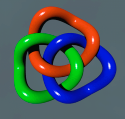 Helium-8 (8He) is the most neutron-rich matter that can be synthesized on earth: it consists of two protons and six neutrons, and remains stable for an average of 0.2 seconds. Helium-6 (6He) has an average lifetime of 1.2 seconds and is a classical example of a Borromean three body system (alpha core plus two neutrons), where no pair of it's three constituents can form a bound system. Unlike regular helium (3He and 4He), which usually has two and occasionally one neutron that pack closely with two protons, the additional neutrons in 6He and 8He form halos around a compact, 4He like core. Because of their intriguing properties, these nuclei have the potential to reveal new aspects of the fundamental forces among the constituent nucleons.
Helium-8 (8He) is the most neutron-rich matter that can be synthesized on earth: it consists of two protons and six neutrons, and remains stable for an average of 0.2 seconds. Helium-6 (6He) has an average lifetime of 1.2 seconds and is a classical example of a Borromean three body system (alpha core plus two neutrons), where no pair of it's three constituents can form a bound system. Unlike regular helium (3He and 4He), which usually has two and occasionally one neutron that pack closely with two protons, the additional neutrons in 6He and 8He form halos around a compact, 4He like core. Because of their intriguing properties, these nuclei have the potential to reveal new aspects of the fundamental forces among the constituent nucleons.
Atomic Isotope ShiftBy measuring the isotope shift of atomic transitions, the difference in the charge radii of helium isotopes can be determined. The isotope shift depends on the change in nuclear mass (mass shift, ~ 40 - 60 GHz) and the difference in charge radius (field shift, ~1 MHz ). The mass shift can be calculated very precisely for this two electron system using modern atomic theory . The field shift is then extracted by subtracting the calculated mass shift from the measured isotope shift. The challenge lies in the high precision requirement for the isotope shift measurement (~ 100 kHz uncertainty in the isotope shift correlates to about 1% error on the charge radius), the small available number of the short-lived 6He and 8He atoms at on-line facilities and the fact that in helium high resolution laser spectroscopy is only possible from the metastable 23S1 level. |
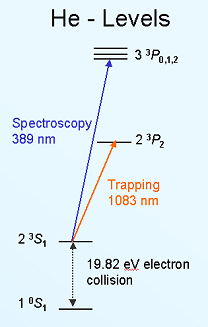 |
Experimental Setup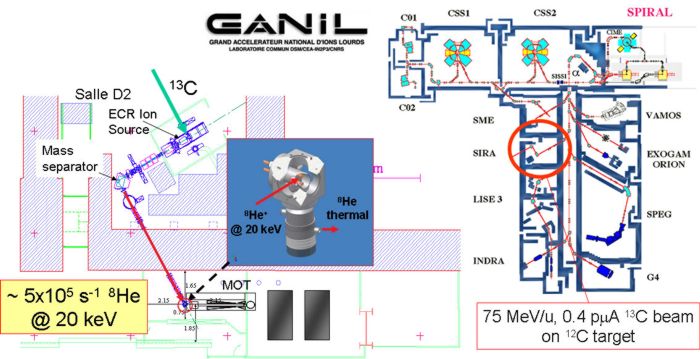
While the production of 6He was carried out at the ATLAS ion accelerator at Argonne National Laboratory, the production of sufficient amount of 8He was accomplished at the GANIL cyclotron facility in Caen, France. In both cases, the short lived helium isotopes produced in a nuclear reaction were transferred to the atomic beam apparatus. To perform the high resolution laser spectroscopy we took advantage of atom trap trace analysis (ATTA), which has been developed by our group for the trace detection of 81,85Kr. This method is based on trapping the desired isotope in a magneto optical trap (MOT), and detecting it by observing the fluorescence light. It has been demonstrated that ATTA is virtually background free and is capable of detecting single atoms. Additionally, the atom is inherently cooled while in the trap and the Doppler broadening is largely reduced. ATTA allowed us to perform the precision spectroscopy on single atoms. To avoid light shift, the trapping light at 1083 nm has to be turned turned off during each spectroscopy period. The spectroscopy laser at 389 nm is scanned over 18 MHz in 6 Microseconds, with a probing-recooling duty cycle of 1:4. A combination of two detuning frequency in the trapping light enables the efficient recooling while maintaining large loading efficiency.
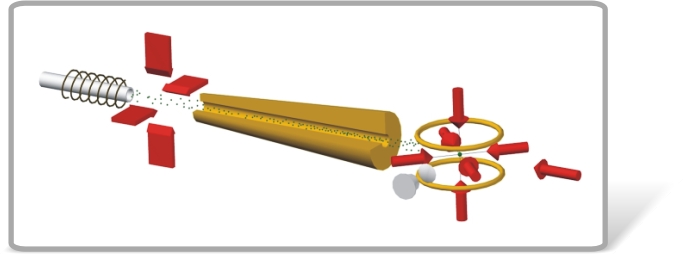
ResultsA precision of better than 100 kHz in measuring the isotope shift between 4He, 6He and 8He has been achieved. With the help of precision atomic theory calculation, the charge radii could of these isotopes could then be determined to be 2.068(11) fm and 1.93(3) fm for 6He and 8He, respectively. This result is independent of nuclear models of the charge distribution and can now be compared to predictions from various nuclear theories. |
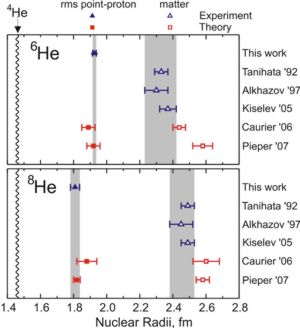 |
 |
|
This work was supported by the U.S. Department of Energy, Office of Nuclear Physics, under Contract No. DE-AC02-06CH11357. The experiment was performed at GANIL (IN2P3/CNRS - DSM/CEA).
References
Colloquium: Laser probing of neutron-rich nuclei in light atoms Abstract / PDF
Z.-T. Lu, P. Mueller, G. W. F. Drake, W. Nörtershäuser, Steven C. Pieper, and Z.-C. Yan
Rev. Mod. Phys. 85, 1383 (2013)
Nuclear Charge Radius of 8He
P. Mueller, I.A. Sulai, A.C.C. Villari, J.A. Alcantara-Nunez, R. Alves-Conde, K. Bailey, G.W.F. Drake, M. Dubois, C. Eleon, G. Gaubert, R.J. Holt, R.V.F. Janssens, N. Lecesne, Z.-T. Lu, T.P. O'Connor, M.-G. Saint-Laurent, J.-C. Thomasand L.-B. Wang
Physical Review Letters 99, 252501(2007)
Laser Spectroscopic Determination of the 6He Nuclear Charge Radius PRL Abstract / Preprint (nucl-ex/0408008)
L.-B. Wang, P. Mueller, K. Bailey, G. W. F. Drake, J. P. Greene, D. Henderson, R. J. Holt, R. V. F. Janssens, C. L. Jiang, Z.-T. Lu, T. P. O’Connor, R. C. Pardo, K. E. Rehm, J. P. Schiffer, X. D. Tang
Physical Review Letters 93, 142501 (2004)
Fine Structure of the 1s3p 3PJ Level in Atomic 4He: Theory and Experiment PRL Abstract / Preprint (physics/0407114)
P. Mueller, L.-B. Wang, G. W. F. Drake, K. Bailey, Z.-T. Lu, and T. P. O'Connor
Physical Review Letters 94, 133001 (2005)
Towards measuring the charge radius of 6He and 8He
P. Mueller, L.-B. Wang, K. Bailey, G.W.F. Drake, X. Du, J. Greene, A.M. Heinz, R.J. Holt, D. Henderson, R.V. Janssens, C.-L. Jiang, C. Law, Z.-T. Lu, I.D. Moore, T.P. O'Connor, R.C. Pardo, M. Paul, T. Pennington, K.E. Rehm, J.P. Schiffer
Nuclear Instruments and Methods in Physical Research B204, 536 (2003)
![[Argonne Logo]](/images/argonne_header_logo.jpg)
![[DOE Logo]](/images/header_doe.gif)